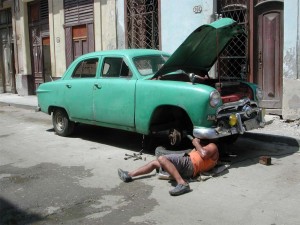It’s been a matter of pride – as much as frustration – for Cuban drivers to maintain a fleet of vehicles that dates back to the pre-Castro era, mostly American Ford, Chevrolet Bel and even long-gone Studebaker. But starting October 1st, the Communist government takes a significant step that could ultimately change the face of a country that, to tourists, has seemed lost in time.
Published in the party’s Official Gazette after months of delays, the new law won’t necessarily bring a flood of new Chevys and Fords – never mind Toyota, Volkswagens or Hyundais – to the island nation. But it will take the first step by legalizing the sale and purchase of automobiles by all Cuban citizens.
Only a rare few have been allowed to actually trade cars, and the number who could anything new – notably Russian-made products like a Lada – was even smaller, mostly doctors, musicians and athletes who have been given permission to travel abroad. A limited number of government workers have also been given cars – though use was closely monitored, reports the AP.
The law, which goes into effect over the coming weekend, will require both buyers and sellers to pay a 4% sales tax – and purchasers will have to declare they didn’t obtain their money illegally. Considering the low income of the average Cuban, which can be measured in dollars a day, that likely will mean relatively few will be qualified to sell anything new.
The old law severely restricted sales of anything built after 1959, when Fidel Castro and his followers came to power.
The new rules are the latest in a series of steps taken under Raoul Castro, the younger brother of Fidel, who took over the helm after the bearded former guerilla leader suffered serious medical problems several years ago. Among other things, the government will loosen strict controls on the sale of property. Some small businesses can now be established, though the rules are generally seen as quite restrictive.
Until now, selling a car was difficult. But the revised law will make it easier – even for those leaving the island permanently.
Since only a modest number of new vehicles will likely make it onto the streets, Cuban drivers will likely continue to seek out ways to keep those old Chevys and Fords running indefinitely, but the news is being hailed by some as a first step that could eventually result in a big change for what has been described as a rolling museum.


I love pictures of these cars on the old streets of Cuba… This is as much “art” for me as the landscape paintings of the 1800s. I love the idea that these cars have been handed down for generations, likely as a reminder of better times before Castro.
After years of owning far more modern 60s/70s collector cars, I just bought a seafoam-green ’51 Chrysler Imperial, 49,000 miles and original (with a patina) down to the slightly faded paint and lightly pitted chrome.
It reminds me of the Cuban cars. It’s enourmous and heavy, but somehow an absolute blast to drive. (Amazingly reliable and leak-free too!) I drive it far more than my historic plates should allow… Guilty!
Viva Cuba!
In some ways I am very happy to see Cuba moving forward, yet there has been something quaintly wonderful about their being stuck in time.
Of course, I haven’t had to live with a ’50s-era Studebaker as my daily driver…
Paul E.